Sector
-
- Are Offshore Ports the Future? Maritime Reporter, Dec 2014 #58
The benefits of offshore ports in the U.S. & Africa
In many parts of the world, offshore ports are a good solution for meeting the requirements of the rapid changes in the international container and bulk shipping industry. Bigger ships, changing routes and destinations require larger and deeper ports, which port owners and operators can be confident will be capable of handling ever-increasing sizes of vessels for many years to come.
Changing Shipping Routes
One of the major challenges in the current container shipping industry is to bundle and organize capacity in the most economical way. In terms of vessel size, Maersk is leading with its Triple E vessels, but the capacity of these new, larger ships needs to be combined with other main carriers in order for it to be effective. Various alliances have been formed, and new ones are being developed. As part of this process, capacity is being shifted to routes which haven’t changed for many years, for example in West Africa. Due to the so-called cascading down process, ships which were never originally intended for use in West Africa will now soon be there. Ports like Abidjan are already anticipating these changes and looking at possible solutions. Others are talking about it but haven’t really started to tackle the issue yet. However, many of the traditional ports lack the physical possibilities (in terms of size, depth, finance, etc.) to make the changes required to enable them to cater for larger vessels and increased capacity. As a consequence, offshore hubs along parts of the West and East African coasts are a solution: in the Guinea–Liberia region for the export of minerals; in the Cameroon–Gabon region for containers; and in Mozambique for bulk. The benefits are massive. We’ve predicted that the savings in investment and operational costs could add up to between 40 to 50 percent.
Similar developments can be seen on the East Coast of the U.S. Due to the same cascading effect and the fact that the biggest container vessels can sail direct via the Suez Canal straight to the U.S. East Coast, an option that is rapidly developing as an alternative for the New Panama Canal. The route via Suez has a greater degree of freedom in terms of ship sizes, especially when the planned increase in two-lane capacity is ready. The big question now is if and how quickly the U.S. East Coast ports can adjust to this development. New cranes have just been ordered and installed for the New Panamax vessel sizes. Some ports have dredged their channels and quays and widened their basins at substantial cost. Others aren’t yet ready to do this, which might be an advantage. Investing in an offshore port could be the best solution by providing a hub for a whole region with fewer limitations for long term development than is often the case in existing ports without limitations in free height (draft), which is an issue in New Jersey for instance, or for various environmental reasons.
Are Offshore Ports a Solution?
Some coasts are just not suitable for deep water ports due to their extended shallow foreshore. For a required water depth of say 20 m, a deep water port might need to be 15 km or more away from the shoreline. This is a situation found along large parts of the African coast, particularly in West and East Africa. So instead of bringing the ship to the port and dredging long and deep channels and port basins on the coastline, one solution could be to bring the port to the ship at the required water depth with an offshore port providing various handling facilities for bulk and/or terminals for containers. Barging the cargo to and from the offshore facility and terminals to nearby coastal or river ports, and using existing corridors and facilities can thus save on capital construction and operational costs. It can also reduce the environmental impact and minimize the ecological footprint. By concentrating present and future development in one spot, an offshore port could work very well not just in Africa but also in the U.S. Currently, up to 70 percent of all West Coast containers move east by rail and road. If only 20 percent of these containers would shift from overland transport to all-water direct import via the Suez Canal to an East Coast offshore port, this would save:
• 20 to 30 percent on direct freight costs from the Far East to the U.S. East coast due to the all-water economy of larger scale shipping
• 30 to 40 percent (or even more) on direct freight costs due to 40 to 50 percent shorter overland transport distance in the U.S. itself
• 20 to 30 percent in emissions on the all-water-route (lower fuel consumption, more efficient engines) plus a 40 to 50 percent reduction in overland transport emissions.
The estimated overall cost reduction for an East Coast multi-user offshore hub compared to improving existing ports and relying on overland transport to be between 30 to 40 percent for both investment and operations. And lower freight costs could also mean lower consumer prices and therefore be better for the overall economy. Instead of ships first going via Caribbean hubs, having an offshore port hub in the United States would mean that without extra handling, the industry can keep money and jobs in the U.S.
For the mining industry, using an offshore hub would provide overall better performance and therefore easier overall feasibility of the whole development, which means earlier viability of the development of the whole prospect. Mining projects that weren’t feasible in the traditional setting with a rail link and one or more coastal ports can become viable when choosing an offshore hub. Even more so, when in combination with (inland) barging or coastal shipping.
The Concept
In the offshore port model, no dredging is required as the facility is placed in water of sufficient depth, say 20 to 22 meters. In order to avoid or reduce the need for expensive breakwaters, technologies such as dynamically controlled mooring and proactive fender systems will be used to guarantee safe operations and a sufficient wide operating window for handling the cargo.
For bulk, the degrees of freedom are usually much larger than for containers, which is why these dynamic systems are being used on an increasing number of container terminals all over the world, especially in existing ports with heavy swell issues.
For containers, the offshore hub would consist of a smart terminal arrangement of say two or three berths for the main carriers and four or five for barges to nearby ports and coastal shipping. The facilities can be extended in almost any combination with dry bulk, wet bulk and containers, depending on zoning and safety requirements.
This concept is not entirely new. Bechtel has already built the deep water Khalifa Port and Khalifa Industrial Zone in Abu Dhabi, one of the world’s largest combined port and industrial zone developments. However, Khalifa Port is connected to the mainland by a causeway and bridge and the offshore hub proposal is essentially an island. There are similarities in terms of port and terminal operations, as well as scale. The offshore hub would be able to handle up to 4 million TEU per year.
Conclusion
The offshore hub represents a viable solution to the future needs of ports, which need to adapt to the ever-increasing sizes of vessels, particularly in the U.S. and Africa. Offering the opportunity to save costs, minimize environmental impact and increase capacity, this concept could provide the answer where traditional ports cannot. Its prospects look promising. In Africa, the multi-user offshore port concept provides a strategic solution by maximizing the benefits of infrastructure corridors. While in the U.S., Bechtel is currently in discussions with various government agencies about the development of an offshore port on the East Coast.
The Author
Marco Pluijm is responsible for the Bechtel’s Port and Marine sector, which includes business and project development, worldwide, technology development, as well as innovation in the maritime sector. He has more than 35 years’ experience in planning and building ports across the globe. As part of the innovation cluster, he is currently leading a joint-industry project (JIP) into the safer mooring of large cargo ships in open water, transhipment, along the coast of West Africa. And recently led the highly-acclaimed ROPES JIP research project for the assessment of the quantitative effects of passing ships on moored ships, which resulted in new international guidelines for the design of safer ports. Mr. Pluijm previously worked for a port authority, a dredging company, an international port consultancy and the Ministry of Transport in the Netherlands. He has an MSc Civil Engineering in port planning and design from Delft University of Technology, the Netherlands.(As published in the December 2014 edition of Maritime Reporter & Engineering News - http://magazines.marinelink.com/Magazines/MaritimeReporter)
-
- The Deepwater Sector's Perfect Storm Marine Technology, Jan 2015 #8
Impact of $50 Oil & Petrobras Implosion on Contracting in the Floating Production Sector The drop in oil/gas prices and ongoing implosion in Petrobras have combined to create a perfect storm in the deepwater sector. More than 170 projects involving oil production floaters and 35 floating liquefaction
-
- Energy Sector Volatility Affects Middle Market M&A Activity Maritime Logistics Professional, Q4 2014 #16
Market volatility for the petroleum sector provides a backdrop to an evolving Merger & Acquisitions environment for the Offshore Sector. In the 3Q edition of Maritime Professional, this series of articles examined the overall evolution of maritime and offshore M&A activity since 2010, tracing the flow of
-
- Turkey Maritime Sector Alive & Kicking Maritime Reporter, Mar 2015 #24
geographical location finds Turkey in a very favorable position. Despite the general economic recession, the country’s shipping ports and shipbuilding sectors have faced challenges resolutely and expanded consistently. With a coastline of approximately 8,483 km, (1,067 km of which are island shores) Turkey
-
- Eniram Launches New Optimization Product for LNG Sector Maritime Reporter, Apr 2014 #104
Eniram Limited, a provider of energy management technology and data analytic services to the shipping industry, announced an advanced fuel-saving product based on the Eniram vessel platform. VPM for LNG in a nutshell: • Collection of the most critical data for LNG operators and owners such as boil-off
-
- Streamlined Service for the Offshore Sector Marine News, May 2014 #53
of Mexico in Alabama, Mississippi and Texas, Signal is poised to ramp up its services to an equally vibrant offshore oil and gas industry and its support sector. The ABC’s of High Blocking Signal Ship Repair (SSR) has the ability to dry dock up to 600 foot vessels draughting over 24 feet of water on 12
-
- A Pivotal Year for AUVs in the Oil & Gas Sector Marine Technology, May 2014 #24
AUVs are on their way. With vast scope for their application, autonomous underwater vehicles are finally gaining pace in the commercial sector. The technology, which has its origins in military activities such as mine counter-measure and rapid environmental assessment (MC & REA), also has a strong presence
-
- Maritime Security for the Municipal Sector Marine News, Oct 2015 #33
utility or features, the Metal Shark 75’ Endurance and the Moose M3 models both provide multi-missioned platforms for the cash-strapped municipal sector. A crowded field for today’s domestic boatbuilders and a highly competitive marketplace finds builders trying to position their output and designs
-
- Interview: Aaron Smith Zeroes in on the Offshore Sector Marine News, Sep 2016 #12
the highest standards of safety and environmental protection among its member companies. Listen in this month as Aaron Smith zeroes in on the offshore sector and the issues important to those stakeholders. Arguably, no one else today is in better position to do so. What’s the number one thing on your
-
- Brexit: What’s in Store for the Subsea Sector? Marine Technology, Nov 2016 #28
has plunged the industry into uncertainty and the UK must now wait to see how June’s historic vote shapes the future of one of its fastest growing sectors. The interconnected nature of subsea, renewables and offshore activities makes predicting impacts even more difficult as the market attempts to understand
-
- ABS' Howard Fireman Weighs in on the US Brown Water Sector Marine News, Mar 2017 #12
the ABS Nautical Systems Fleet Management Software product line where he has overseen significant advancements in the software and achieved growth in every sector. Fireman came to ABS from the U.S. Navy, where for over 35 years he was recognized as a distinguished leader in the areas of naval ship design, hull
-
- Driver-less Ships: Autonomy in the Maritime Sector Maritime Reporter, Dec 2017 #22
In a show of prototypes, a pod of unmanned sailboats from around the world competes to cross “The Atlantic” test tank in Horten, Norway. Cross the real ocean, and the Sail Bots race similarly challenges scholarly robotic-vessel designers to North America for a bit of station-keeping, collision-avoidance and
-
 )
March 2024 - Marine Technology Reporter page: 45
)
March 2024 - Marine Technology Reporter page: 45base that includes: subsea, hydrographic, metrological and positioning, oceanographic, ports, har- bours, dredging, energy and scienti? c research sectors. • Greensea IQ Signs Contract with BUVI Greensea IQ, announced the signing of BUVI Scandinavia (BUVI) to join its international sales team, which
-
 )
March 2024 - Marine Technology Reporter page: 29
)
March 2024 - Marine Technology Reporter page: 29and is ex- pected to con? rm mining guidelines this July, or perhaps next. Nearly two thirds of the licenses are for nodule mining, the most advanced sector. Belgium-based GSR, part of the DEME Group, has Transocean as a cornerstone in- vestor, and it conducted trials of a patented nodule collector, Patania
-
 )
March 2024 - Marine Technology Reporter page: 19
)
March 2024 - Marine Technology Reporter page: 19a relatively limited extent of time. Also, because FiGS sales, marketing and management in data is combined with detailed CP models developed using the sector since 2001. FORCE Technology’s SeaCorrTM software, it’s possible to easily identify issues such as hotspots including areas of un- tion based on condition
-
 )
March 2024 - Marine Technology Reporter page: 6
)
March 2024 - Marine Technology Reporter page: 6on the academic advisory institutions, and nonpro? ts board of Instituto Milenio in the ocean, weather, de Oceanografía at the climate, and space sectors. Universidad de Concep- Gallaudet is a former acting ción, Chile. Hardy received Undersecretary and Assistant an honorary Doctor of Sci- Secretary
-
 )
March 2024 - Marine Technology Reporter page: 4
)
March 2024 - Marine Technology Reporter page: 4that we Manager, Marketing recorded nearly two dozen interviews across most ever geographic local and product/tech Mark O’Malley [email protected] sector you could imagine; interviews that will ? ll our Marine Technology TV feed on Accounting www.marinetechnologynews.com/videos. This mass of editorial
-
 )
April 2024 - Maritime Reporter and Engineering News page: 39
)
April 2024 - Maritime Reporter and Engineering News page: 39stationary barge fuel for shipping. With ammonia’s potential to fully decar- with a capacity of 1000 cubic meters, or 650 tons, of am- bonize the maritime sector, the companies plan to roll out a monia. The permit allows for up to 416 operations annually, network of terminals in Scandinavia. many of these
-
 )
April 2024 - Maritime Reporter and Engineering News page: 21
)
April 2024 - Maritime Reporter and Engineering News page: 21in offshore energy production. From Also – like most companies in the maritime and offshore that start he – like most other burgeoning leaders in the sector sectors – today it is not possible for ABS to put a de? nitive – became ‘mobile and global’, working with SBM in the ? oat- number on ‘how fast
-
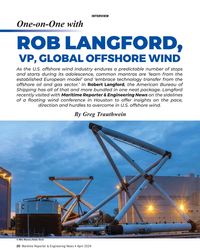 )
April 2024 - Maritime Reporter and Engineering News page: 20
)
April 2024 - Maritime Reporter and Engineering News page: 20during its adolescence, common mantras are ‘learn from the established European model’ and ‘embrace technology transfer from the offshore oil and gas sector.’ In Robert Langford, the American Bureau of Shipping has all of that and more bundled in one neat package. Langford recently visited with Maritime
-
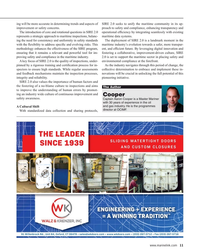 )
April 2024 - Maritime Reporter and Engineering News page: 11
)
April 2024 - Maritime Reporter and Engineering News page: 11fostering a collaborative, improvement-driven culture, SIRE proving safety and compliance in the maritime industry. 2.0 is set to support the maritime sector in placing safety and A key focus of SIRE 2.0 is the quality of inspections, under- environmental compliance at the forefront. pinned by a rigorous
-
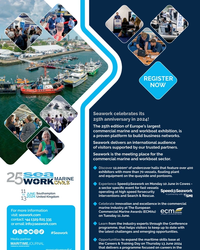 )
April 2024 - Maritime Reporter and Engineering News page: 7
)
April 2024 - Maritime Reporter and Engineering News page: 7delivers an international audience of visitors supported by our trusted partners. Seawork is the meeting place for the commercial marine and workboat sector. 2 Discover 12,000m of undercover halls that feature over 400 I\LMFMXSVW[MXLQSVIXLERZIWWIPW?SEXMRKTPERX and equipment on the quayside and pontoons
-
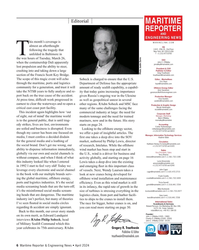 )
April 2024 - Maritime Reporter and Engineering News page: 6
)
April 2024 - Maritime Reporter and Engineering News page: 6starts on page 24. Esther Rothenberger [email protected] are soiled and business is disrupted. Even Looking to the offshore energy sector, +1.212.477.6700 ext 6810 though my career has been one focused on we offer a pair of insightful articles. The Manager, Information Technology Services m
-
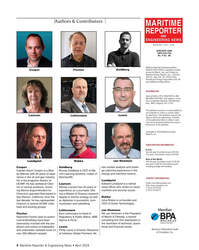 )
April 2024 - Maritime Reporter and Engineering News page: 4
)
April 2024 - Maritime Reporter and Engineering News page: 4Mas- Murray Goldberg is CEO of Ma- gic planning experience in the ter Mariner with 30 years of expe- rine Learning Systems, maker of energy and maritime sectors. rience in the oil and gas industry. MarineLMS. CONTACT INFORMATION: He is the programs director at Lundquist Email: [email protected] OCIMF
-
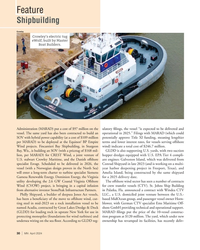 )
April 2024 - Marine News page: 30
)
April 2024 - Marine News page: 30Renewable Energy. Dominion Energy, the Virginia for a 2025 delivery date. utility developing the 2.6 GW Coastal Virginia Offshore The offshore wind sector has seen a number of contracts Wind (CVOW) project, is bringing in a capital infusion for crew transfer vessels (CTV). St. Johns Ship Building from
-
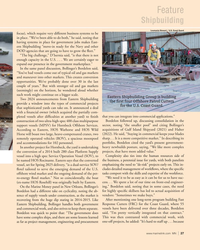 )
April 2024 - Marine News page: 27
)
April 2024 - Marine News page: 27two ultra-high-spec 400 class multipurpose Bordelon followed up, discussing consolidation in the support vessels (MPSV) for Hornbeck Offshore Services. sector, noting “the smaller pool” and citing Bollinger’s According to Eastern, HOS Warhorse and HOS Wild acquisitions of Gulf Island Shipyard (2021) and
-
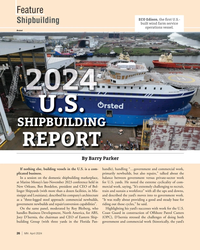 )
April 2024 - Marine News page: 26
)
April 2024 - Marine News page: 26primarily newbuilds, but also repairs,” talked about the In a session on the domestic shipbuilding marketplace, balance between government versus private-sector work at Marine Money’s late-November 2023 conference held in for U.S. yards. He noted the extreme cyclicality of com- New Orleans, Ben Bordelon,
-
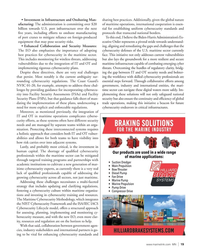 )
April 2024 - Marine News page: 19
)
April 2024 - Marine News page: 19, aligning and remediating the gaps and challenges that the The EO also emphasizes the importance of adopting cybersecurity defenses of the U.S. maritime sector currently best practices for cybersecurity in the maritime sector. face. This initiative not only addresses current vulnerabilities This includes
-
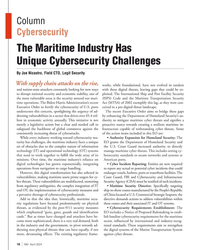 )
April 2024 - Marine News page: 18
)
April 2024 - Marine News page: 18landscape. underscores this concern, spotlighting the urgency of ad- The recent Executive Order aims to bridge these gaps dressing vulnerabilities in a sector that drives over $5.4 tril- by enhancing the Department of Homeland Security’s au- lion in economic activity annually. This initiative is not thority
-
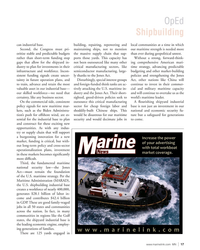 )
April 2024 - Marine News page: 17
)
April 2024 - Marine News page: 17for the shipyard in- not been outsourced like many other ing comprehensive American mari- dustry to plan for investments in their critical manufacturing sectors, like time strategy, advancing predictable infrastructure and workforce. Incon- semiconductor manufacturing, large- budgeting and other market-building
-
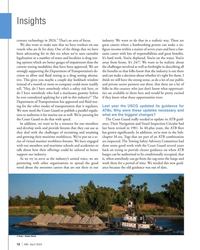 )
April 2024 - Marine News page: 12
)
April 2024 - Marine News page: 12day lookback window think we still have the strong sense, as do a lot of our public instead of a month or more so company could more readily and private sector partners out there, that there are a lot of tell, “Hey, do I have somebody who’s a safety risk here, or folks in this country who just don’t know
-
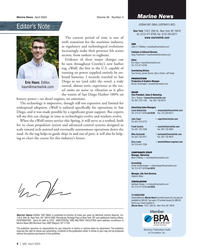 )
April 2024 - Marine News page: 4
)
April 2024 - Marine News page: 4O’Malley • [email protected] increasingly make their presence felt across Publisher & Editorial Director Greg Trauthwein • [email protected] sectors, from tankers to tugboats. Evidence of these major changes can Editor Eric Haun • [email protected] be seen throughout Crowley’s new harbor Tel:
-
 )
February 2024 - Maritime Reporter and Engineering News page: 44
)
February 2024 - Maritime Reporter and Engineering News page: 44advance line with full class approval. Heavy the use of zero-emission ships in the Emission Monitors equipment with a tiny straightening tol- maritime sector, effectively eliminating Green Instruments A/S and Danish erance of max 0.05 mm. emissions such as CO2, NOX, SOX, Technological Institute have
-
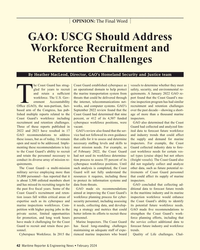 )
February 2024 - Maritime Reporter and Engineering News page: 42
)
February 2024 - Maritime Reporter and Engineering News page: 42future workforce needs. petition with higher paying jobs in the ing a strategy and metrics that could GAO made ? ve recommendations to private sector, limited opportunities better inform its efforts to recruit these strengthen the Coast Guard’s work- for promotion, and long work hours personnel
-
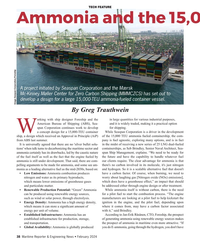 )
February 2024 - Maritime Reporter and Engineering News page: 38
)
February 2024 - Maritime Reporter and Engineering News page: 38that there are no 'silver bullet solu- in the midst of receiving a new series of 25 LNG dual-fueled tions' when talk turns to decarbonizing the maritime sector and containerships, as Seb Brindley, Senior Naval Architect, Sea- ammonia certainly has its drawbacks, led by the caustic nature span Ship Management
-
 )
February 2024 - Maritime Reporter and Engineering News page: 24
)
February 2024 - Maritime Reporter and Engineering News page: 24owner. really helped prop up the unique marine solution. How does the experience from working in mul- Can you discuss Wabtec R&D efforts designed tiple sectors lend to the marine engine line-up? to cut emissions? First and foremost is the design robustness. When we talk Wabtec is committed to offering alternative
